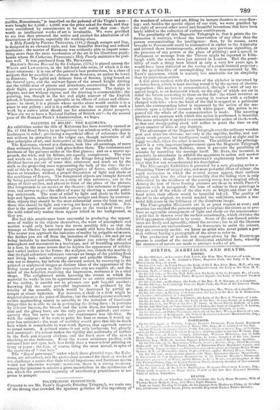PAINTING IN RELIEF: THE KALORAMA.
AN exhibition under the title of Kalorama has been recently opened at No. 17 Old Bond Street, by an ingenious but mistaken artist, who paints landscapes in relief; producing a superficial effect of substance that is not without its attraction to the vulgar eye, though subversive of all true principles of art, and destructive of the illusion intended.
The Kalorama, viewed at a distance, look like oil-paintings, of more than ordinary force, framed with glass before them. The coarseness and hardness of the pictures strike at the first glance ; and on a nearer ap- proach, the trick, and its failure, are equally conspicuous. The trees and weeds are in palpable low relief; the foliage being imitated by in- dividual leaves cut out of some thin substance, and stuck on by the stalk to the projecting mass representing the bulk of the tree : the re- sult of this is a flat, opaque, rigid aggregation of forms, unlike either leaves or branches, without a proper disposition of light and shade or the semblance of flexure. The foreground objects are brought forward by being painted and relieved on a strip of thin substance, cut to the shape of their outline, and placed in front of the plane of the picture, like foregrounds in set scenes at the theatre : this substance is transpa- rent, and serves to give the effect of water by showing a second paint- ing underneath. The want of relief by light and shade in the build- ings and figures, makes them look more meagre and flimsy by contrast : thus, objects that should be the most substantial seem the least so, and those that should be light and waving are heavy and inflexible. Nei- ther is the semblance of rotundity given to the trunks of trees ; for the solid relief only makes them appear inlaid in the background, as they are.
But had this contrivance been successful in producing the appear- ance of reality in the objects themselves, the want of atmosphere and motion would only have been the more sensibly felt ; so that the attempt at illusion by material means would still have been defeated. The nearer you approach the imitation of reality by palpable substance, the farther you are off from the imitation of vitality ; life and air not being imitable by mechanism. The painter can convey the effect of atmosphere and movement in a landscape, and of breathing animation in a face, by the same means that he depicts the appearance of solidity and varied surface in the forms: the sculptor, too, chisels the marble so that its rigid colourless substance conveys an image of the yielding flesh and living look : neither attempt gross and palpable illusion. They aim not to deceive, but inform the outward senses, by conveying in the painted or sculptured images as distinct ideas of the appearance of the living scene or person as their respective arts are capable of; and the mind of the beholder, receiving the impression, recreates it in a vital shape. The enlightened artist, knowing the extent to which the material he works in can be approximated to an entire representation of the reality, is careful not to advance one part beyond another ; knowing that the most powerful impression is produced by the totality of the ensemble, which would be destroyed by partial at- tempts at closer imitation. For instance, a chair or a desk might be depicted almost to the point of illusion ; but the refined painter studiously avoids approaching nearer to actuality in the imitation of inanimate things than he is able to do in portraying the living form : in portraits by inferior limners, the brooch and the satin dress, the buttons of the coat and the glossy boot, are the only parts well painted ; and conse- quently they but serve to make the countenance less life-like. So with the sculptor : if he were to paint his bust or statue, it would ap- pear less animated : the want of mobility would give that life-in-death look which is remarkable in wax-work figures, that approach nearest to actual nature. A painted statue is not only barbarous, but ghastly and unnatural : the colour makes the rigidity and uniformity of surface in the flesh and drapery obvious, and the fixed stare of the eyes is shocking or else ludicrous. Even the waxen miniature profiles, with coloured hair and eyes, look less lively than a water-colour painting on ivory or paper ; the face, of course, being the most unreal, in spite of the eyebrows of "real hair." The "Royal patronage," under which these pictorial toys, the Kalo- rama, are advertised, and the pretensions assumed for them as works of art, challenge 'a notice that their trivial importance and factitious merits would not otherwise warrant : moreover, there is a strong tendency among the ignorant to admire a gross materialism in the mechanism of art, which the perverted ingenuity of unreflecting practitioners is too prone to pamper.


























 Previous page
Previous page